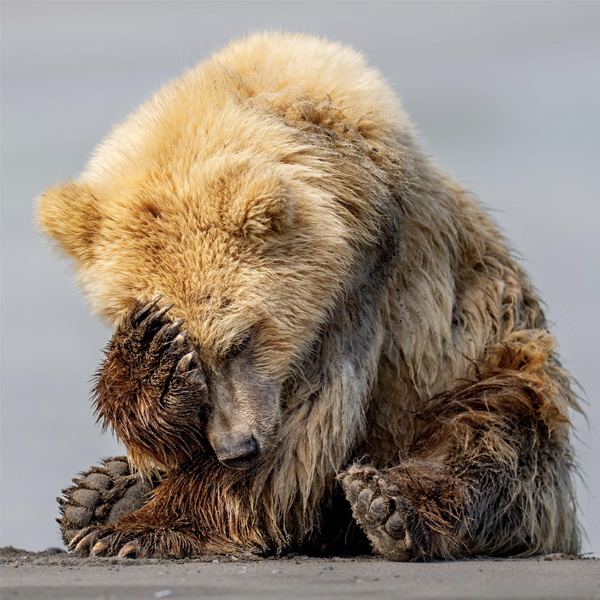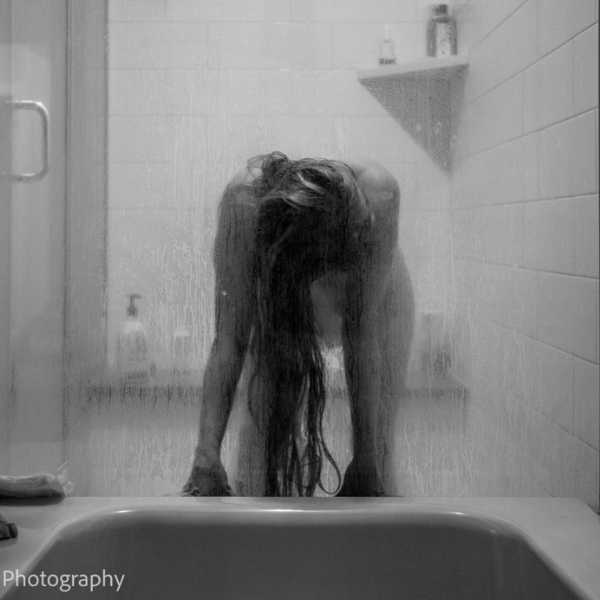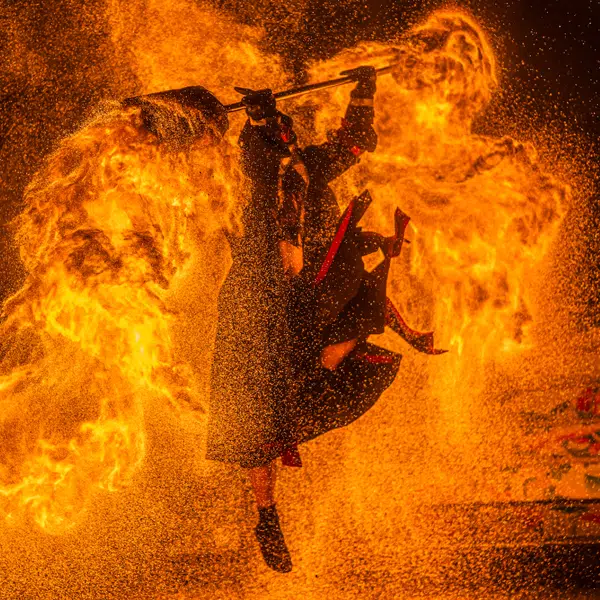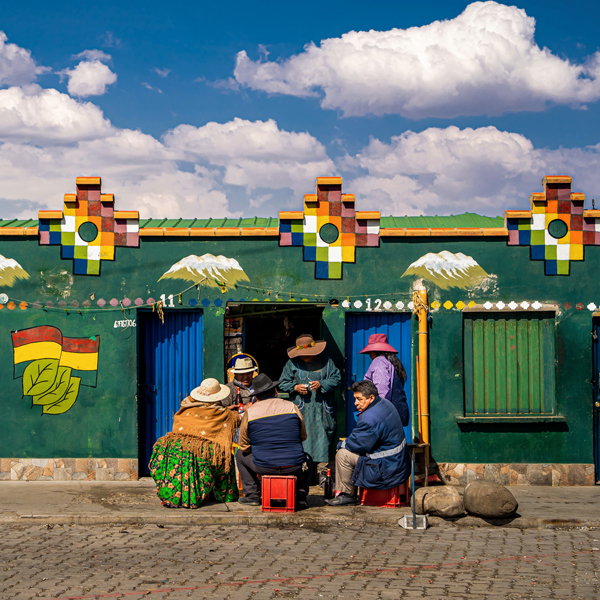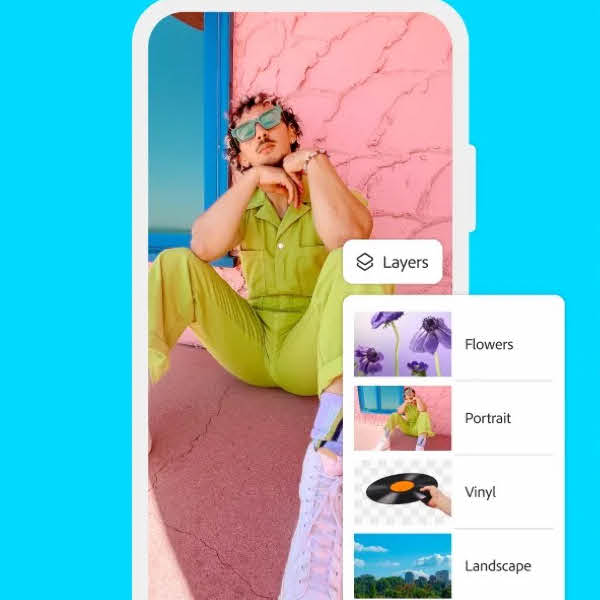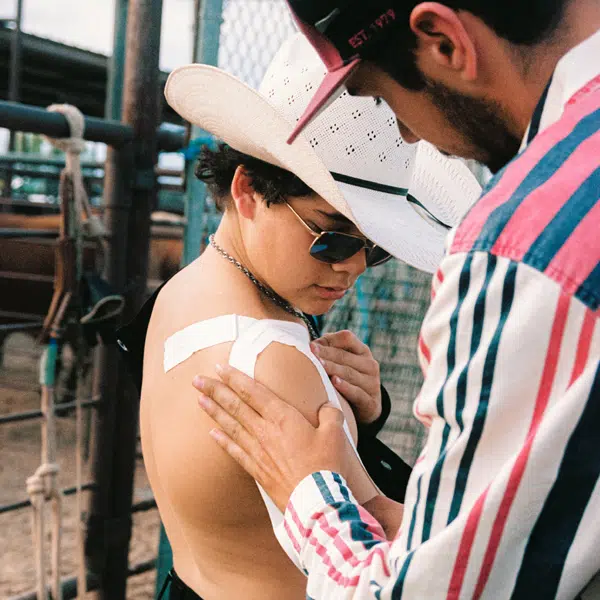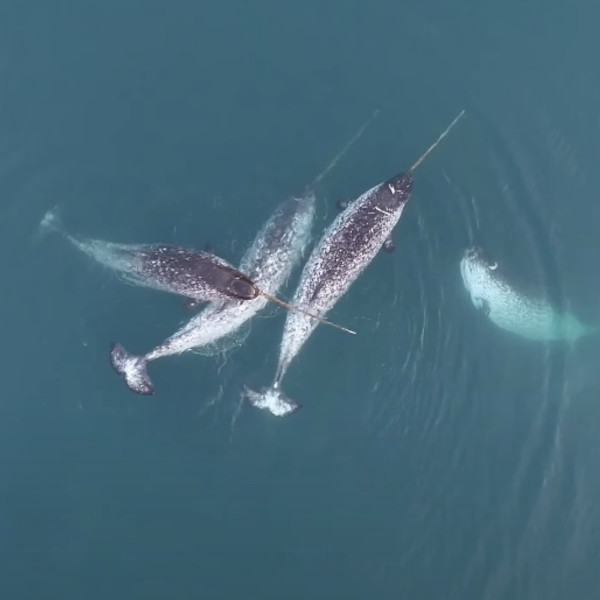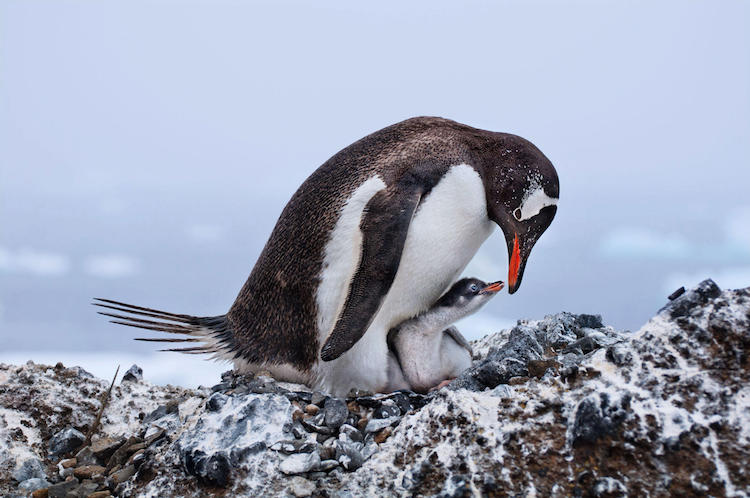
Gentoo Penguin by Deborah Albert. Grand prize winner. Location: Brown Bluff, Antarctica. “I had just bought my first DSLR about two weeks earlier for my trip to Antarctica. We were walking along the beach and, as the group moved on, I noticed this penguin in a nest made of rocks. I watched for a long while and, finally, one chick appeared. I took many shots, but this one, with the parent leaning down, touched me the most—the warmest love in the coldest place. Beginner’s luck, I guess.”
The recently announced winners of the eighth annual Audubon Photography Awards beat out a field of over 5,500 entries across three categories. Celebrating the vulnerability and elegance of our feathered friends, participants entered a wide variety of images that capture all aspects of bird life.
Wildlife photographers from 48 U.S. states and 8 Canadian provinces entered the competition with the hopes to not only win a cash prize and trip, but the possibility to exhibit their work at the 2017 Nature’s Best Photography Exhibition at the Smithsonian National Museum of Natural History.
In the end, the panel of judges, which included Audubon's creative director, as well as the co-publisher of Nature's Best Photography, selected Deborah Albert's photo of a Gentoo penguin as the grand prize winner. Photographed during Albert's trip to Antartica, it captures a warm, familial moment between a parent and its child.
Reading the stories behind the shots, it's clear that patience and the ability to quickly act when the shot comes into frame is key in bird photography. Indeed, the judging criteria, which was based on technical quality, originality, and artistic merit is a trifecta that synthesizes what elevates these stunning wildlife photographs.
If you can't get enough of bird photography, you'll want to explore Audubon's top 100 photos from this year's contest.
The Audubon Photography Awards celebrates the best of bird photography. Here's a look at more of the 2017 winners and top 100 finalists.

Sandhill Cranes and Snow Geese by Karen R. Schuenemann. Professional honorable mention. Location: Bernardo Waterfowl Management Area, New Mexico. “On a cold and stormy late January afternoon, I stood watching a field as thousands of Snow Geese and Sandhill Cranes fed on corn at the Bernardo Waterfowl Management Area. As I waited for them to ascend, I turned around; statuesque trees framed this scene behind me. Dramatic storm clouds surrounded us and there was nothing but flat gray light—until suddenly, the sun broke through just as the birds lifted off.”

Great Gray Owl by Steve Mattheis. Professional winner. Location: Grand Teton National Park, Wyoming. “On a soggy fall morning in Grand Teton National Park, I went on a hike to look for owls. I expected them to be seeking refuge from the drizzle in the dark timber, so I was surprised to see this Great Gray Owl sitting out in the open, getting drenched. After lazily shaking off some water, it took off in my direction. The bird looked like it was flying drunk. It crash-landed into a sapling, gripping tightly with its talons and flapping its wet wings as it struggled for balance. I could tell it was a juvenile, a chick that hatched earlier in the summer, and I thought to myself, ‘This bird has a lot to learn.'”
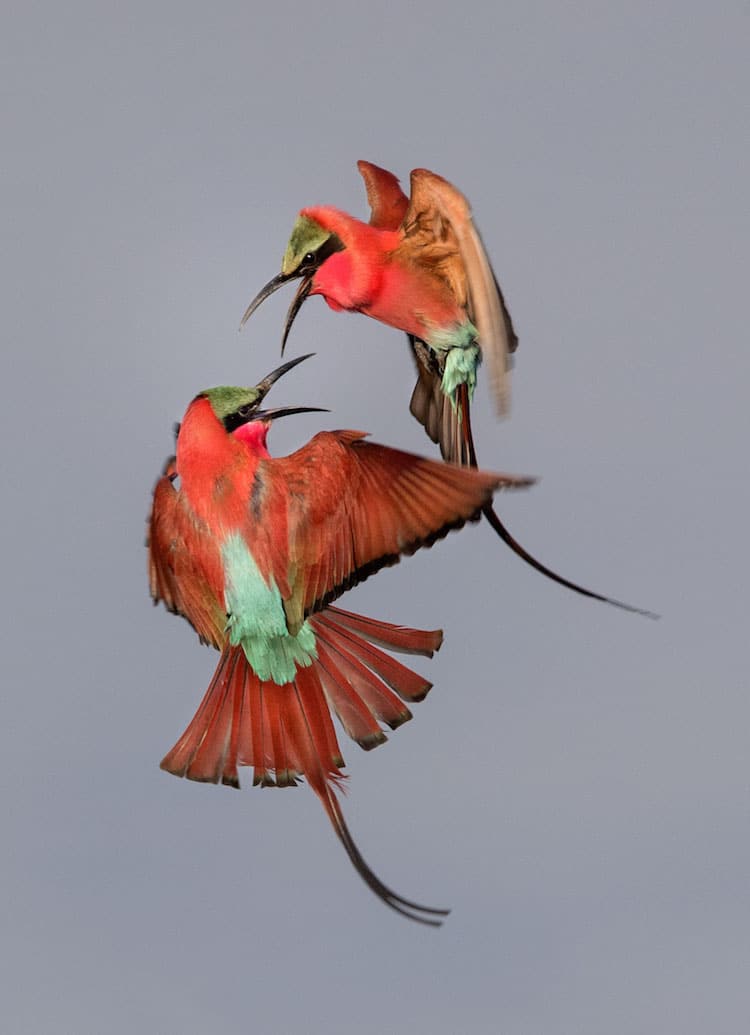
Southern Carmine Bee-eater by Zachary Webster. Youth winner. Location: Luangwa River, South Luangwa National Park, Zambia. “Along a Zambian riverbank in early August, a colony of Southern Carmine Bee-eaters was busy battling for space. Each battle lasted only a few seconds, with the pair lifting off the edge, engaging out over the river, then separating. My challenge was, first, to find a battling pair with a hand-held 600mm lens and, second, to keep them in frame and in focus as they fought. Even with binoculars, a Carmine battle is a short blur of color and beating wings. It was not until I studied my shots that I fully appreciated the jousting and parrying, the widespread tails, the jabs of the beaks. I want to give others the opportunity to feel the same awe.”

Varied Thrush by Heather Roskelley. Amateur winner. Location: Washington Park Arboretum, Seattle. “Washington Park Arboretum in Seattle has a beautiful mountain ash collection that attracts Varied Thrushes. I went there on four of the coldest days this past winter, and every day they were either in the tops of trees or in the back branches—or not there at all because of a marauding Cooper’s Hawk. On the last day, I saw a bird in my peripheral vision. I walked slowly around to position myself; luckily, the thrush was more interested in the tree’s berries, and I was able to capture this eye-level shot. Patience and persistence sometimes pay off.”
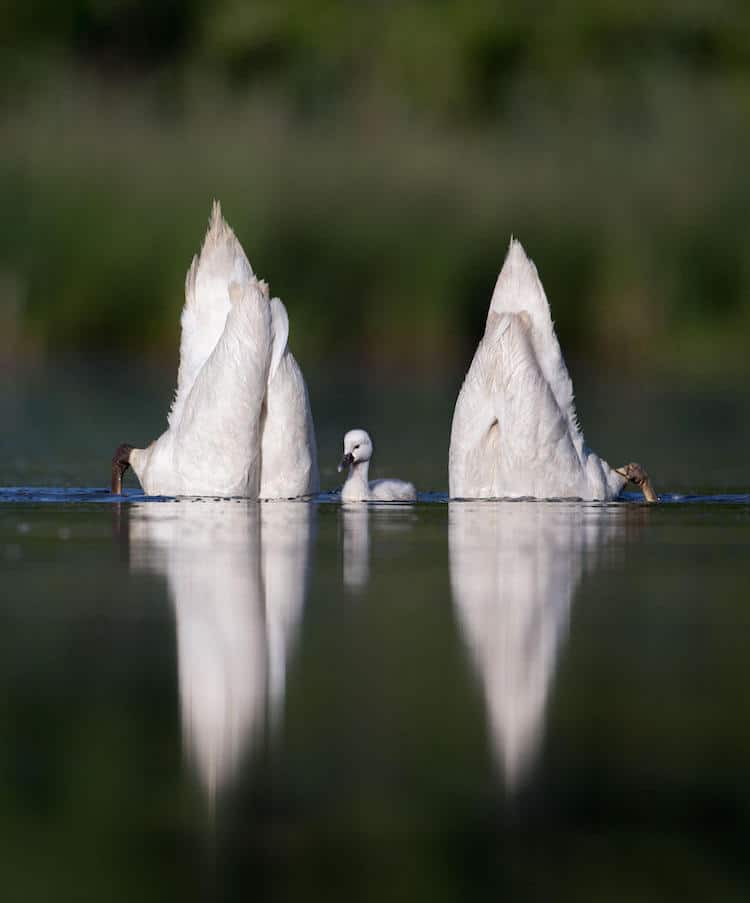
Mute Swan by Chistopher Schlaf. Amateur honorable mention. Location: Washington, Michigan. “As I photographed this family of Mute Swans, I noticed the incredible reflection and light. I felt that if the two parents would tip up at the same time with the baby swan (called a cygnet) in between them, I would have something pretty spectacular—and that’s exactly what happened. To me, the photo represents the struggle for survival as this young swan is the only remaining cygnet of eight, despite having such protective parents.”
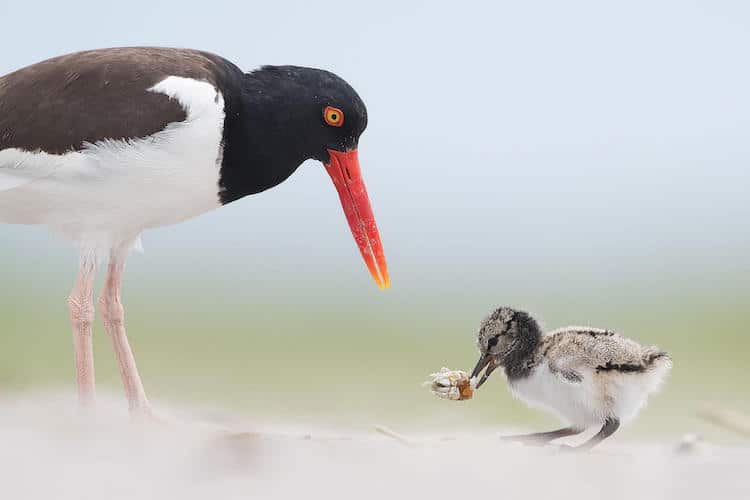
American Oystercatcher by Warren Hatch. Location: Lido Beach, NY. Hatch captured a tender moment between parent and child. After foraging in the surf, the adult American Oystercatcher in this image headed back to the nest with a small crab. One chick spied the meal before his two siblings and hurried over. You could almost sense the parent’s pride (and amusement), Hatch says, as the chick wrestled to break into the crab.

Red-winged blackbird by Nathan Rolls. Location: Bosque del Apache National Wildlife Refuge, San Antonio, NM. In January, Rolls drove from Fort Sill, Oklahoma, to Bosque del Apache to photograph birds during their winter migration. He spent hours sitting on a stool with his camera, and eventually, a swarm of female Red-winged Blackbirds flew into an open field. Rolls snapped a couple photos of the entire flock, ebbing and flowing through the air like a stream, but then homed in on a smaller portion in order to capture the detail of their lattice-like formation and methodical acrobatics.
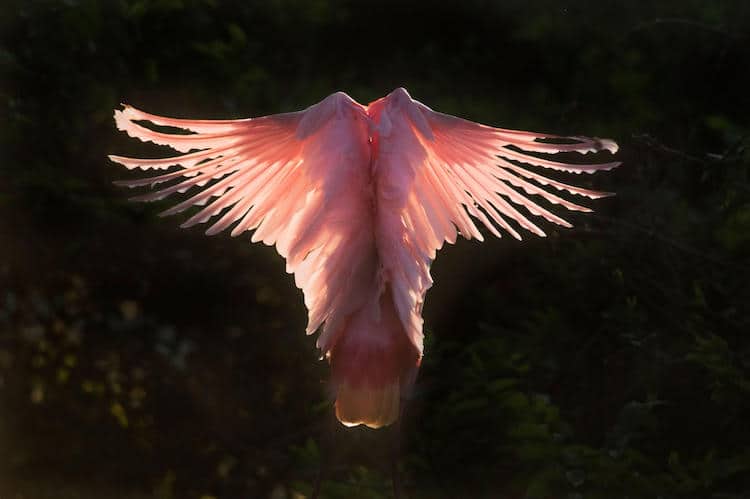
Roseate Spoonbill by Dawn Wilson. Location: Smith’s Oak Rookery, High Island, TX. Wilson arrived at the Smith Oaks Rookery shortly before sunrise, not having had time to scout it the day before. She quickly realized she would have to shoot directly into the sun but decided to make the best of it. When a Roseate Spoonbill flew into the shadows of trees, Wilson hoped she had caught a little bit of light on the bird’s wings. Not only did she get the shot, the warm morning light also magnificently illuminated the soft pink feathers.

Anna’s Hummingbird by Kathleen Elam. Location: Aliso Viejo, CA. A hummingbird’s wings beat more than 50 times per second, so Elam never knows if she got a good shot until she reviews her pictures later. When she saw this one, an Anna’s Hummingbird preparing to attack another at the feeder, she knew it was special. Elam used a macro lens to capture the bird in detail and several flashes set at 1/16th of a flash in order to the stop motion of its wings.
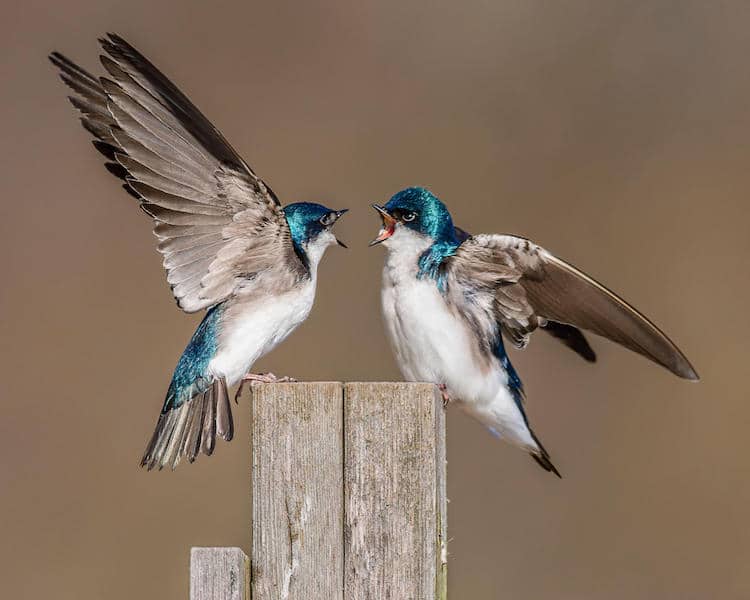
Tree Swallow by Morris Finkelstein. Location: Allen's Meadows, Wilton, CT. Finkelstein set out in search of a rare warbler with some fellow birders. But when he saw male Tree Swallows posturing on a post close to a nest box, he was in the ideal spot to photograph the brief interaction. He never tracked down the warbler, but he felt fortunate to capture this display of avian territorial behavior.
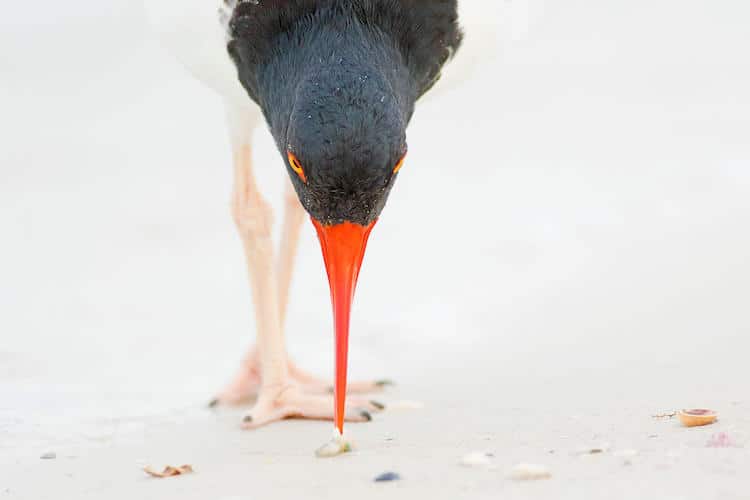
American Oystercatcher by Marie Read. Location: Fort De Soto Park, Pinellas County, FL. The resident oystercatchers at Fort De Soto aren’t fazed by beachgoers, so Read sat on the ground near the waterline and waited until one approached her. She was striving for a close-up of the bird using its chisel-shaped bill to deftly pry open small clams. At one point the oystercatcher came so near she could only include part of it in the frame. The result was this unusual front view with the colorful bill held straight down and both eyes visible.
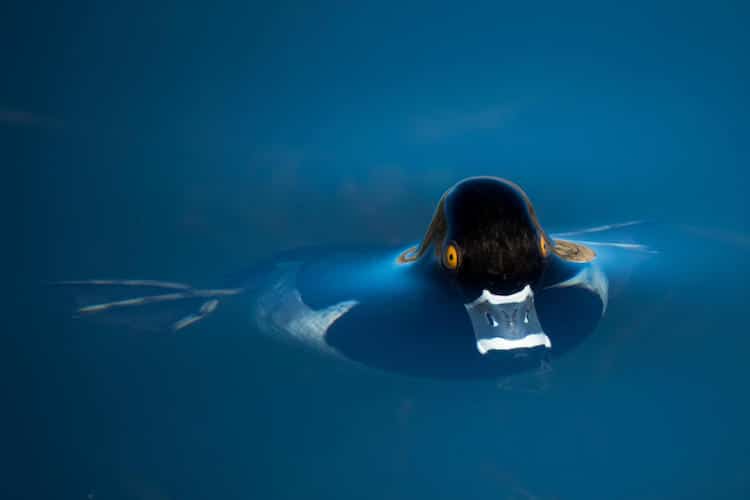
Ring-necked Duck by Chris Hartzell. Location: Dead Horse State Park, Cottonwood, AZ. Hartzell enjoys the challenge of capturing creatures as they rise out of water, pushing surface tension to its max. This Ring-necked Duck at Dead Horse State Park spent just a few minutes diving next to him. Auto focus wouldn’t work so he had to focus manually—a near impossible task. But for the second time in more than 30 years of photography, Hartzell got the image, conveying the unique dynamics of water, that he was after.
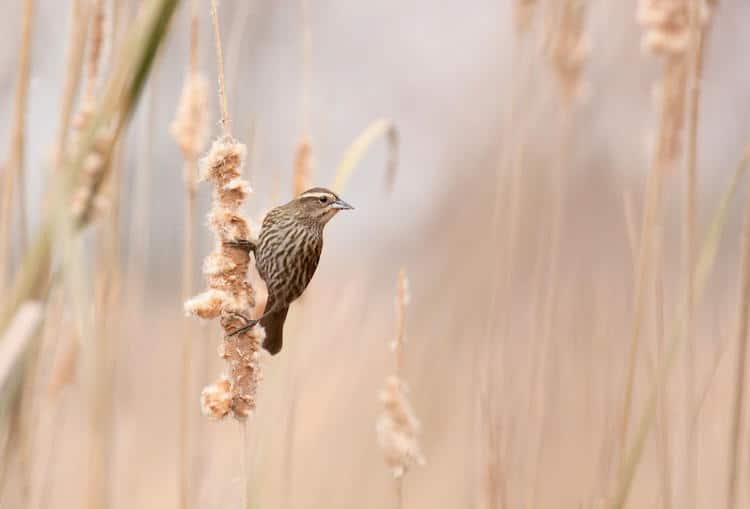
Red-winged Blackbird by Will Hilscher. Location: Lake Pflugerville, Pflugerville, TX. Living in Central Texas, Hilscher is blessed with a huge variety of beautiful birds to photograph. However, he never considered the female Red-winged Blackbird as pretty—that is until he noticed 10 females feeding among the lake’s reeds. It was not just the bird that appealed to Hilscher, but also the habitat. The bird Hilscher never took notice of has now become the subject of one of his favorite photos.
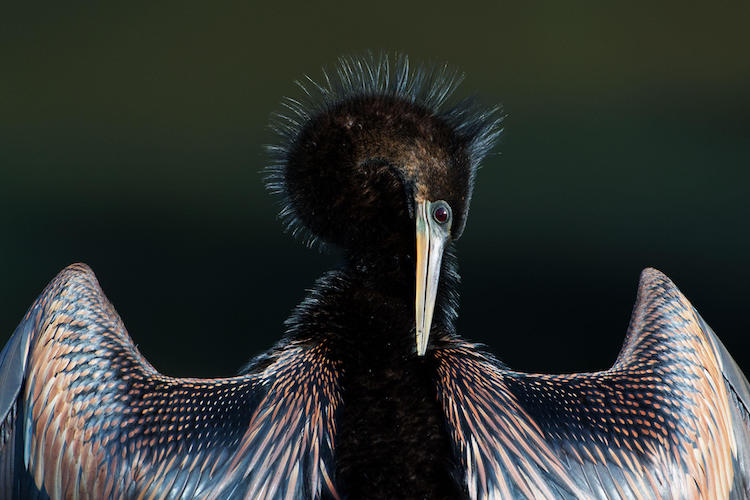
Anhinga by Ralph Gaines. Location: North Augusta, SC. Anhingas are known to search for food underwater by using their long, sharp mandibles. After foraging for a while, they like to spend time with their wings spread in the sun, grooming and airing out their feathers—a moment Gaines captured in this image, which shows off the bird’s unique feather patterns and behavior.

Great Egret by Zeralda LaGrange. Location: Cypress Island Preserve, Breaux Bridge, LA. When she arrived at Lake Martin on a January day, LaGrange was planning to practice shooting landscapes in the early-morning mist. But the lake turned out to be too foggy, so she headed for a nearby rookery—and never made it there. Instead, she stumbled on a host of egrets, cormorants, and anhingas, accompanied by a lone Great Blue Heron. She couldn’t maneuver to a spot she liked, but she didn’t need to, not when this egret took flight, framing the perfect shot within what she calls a “nature cathedral.”
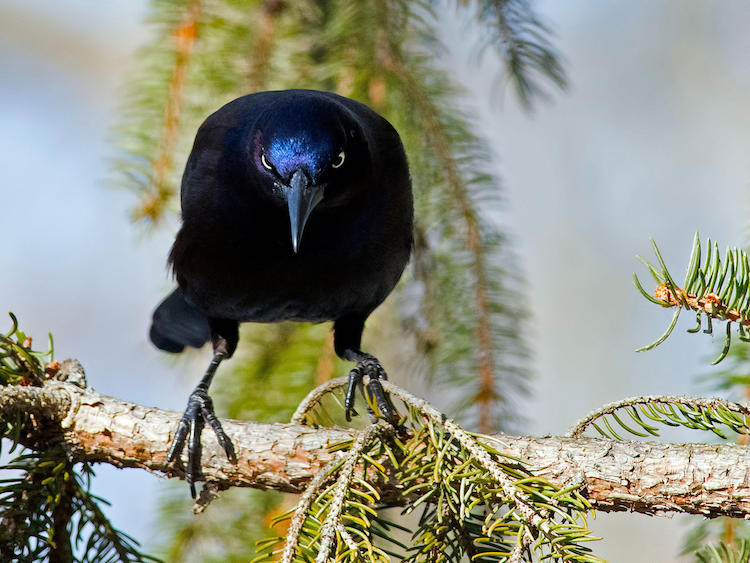
Grackle sp by Brian Kushner. Location: Mariner Point Park, Joppa, MD. Mariner Point Park, a small park in Maryland, attracts a great variety of birds in the winter. Kushner was standing and looking around one day when this grackle landed on a nearby tree. It stared directly at him as he took the shot.
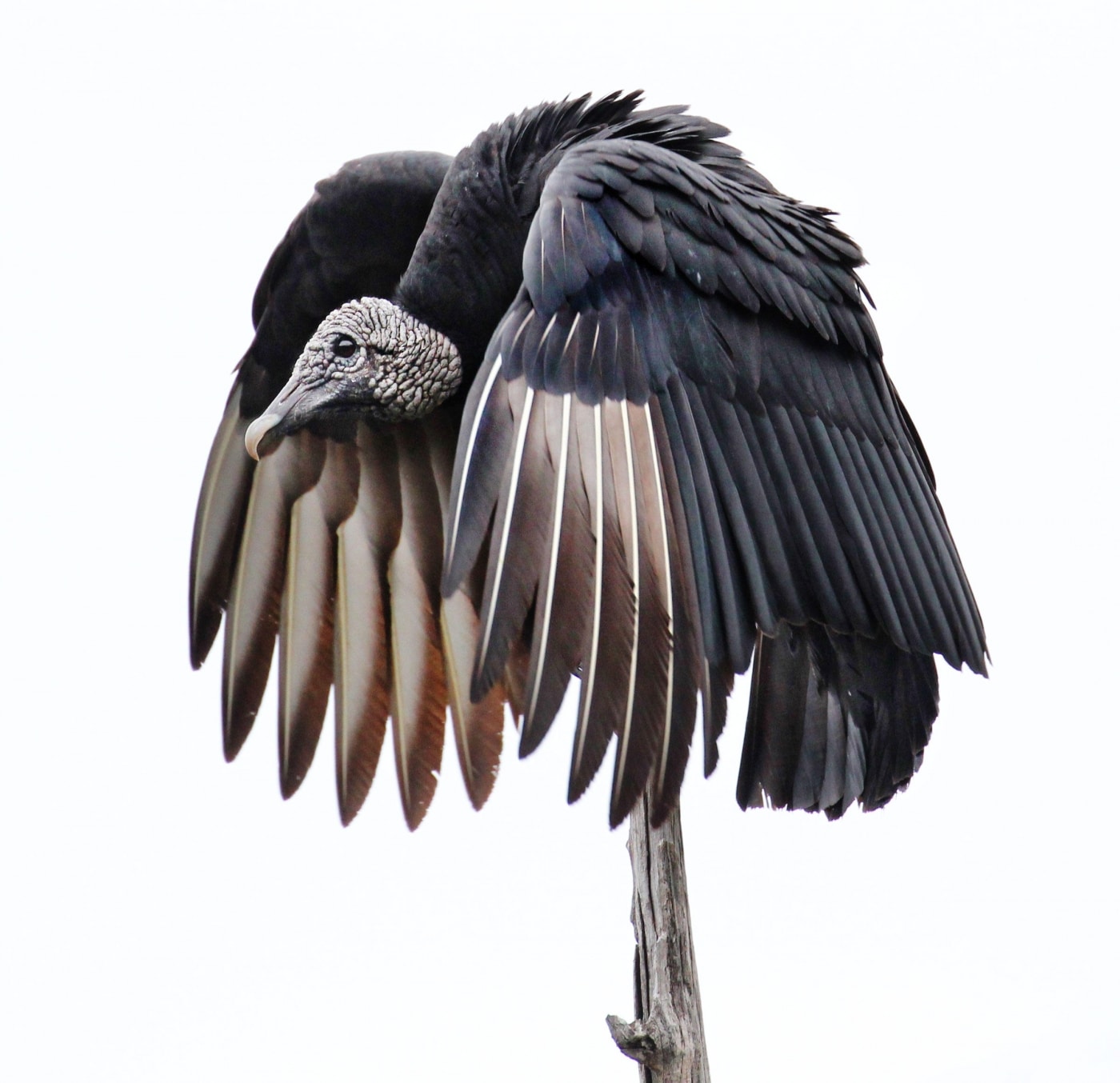
Black vulture by Will Hillscher. Youth honorable mention. Location: Williamson County, Round Rock, Texas. “Because of their plain black coats and rather disgusting eating habits, I often overlook Black Vultures. But then the opportunity arose to photograph a large group feasting on road kill near my house. As I watched them vie for position on a dead tree near their food, I found the vultures to be incredibly feisty and formidable in appearance. The cloudy sky made taking the picture di cult, but by lowering my shutter speed and raising my ISO, I was able to capture this Black Vulture just as he jumped to claim a higher perch. During his effort to balance himself, I snapped this shot.”

Long-eared Owl by Teri Shors. Location: Winnebago County, WI. Shors came across 18 Long-eared Owls roosting in a willow thicket, near an unlimited supply of prairie voles with which to satiate their appetites, in what was the first documented sighting of the species in Winnebago County. She wore a special “owl cap” in hopes that they would welcome her as one of their own and observed the owls for two months. But her biggest hurdle proved to be the thicket itself. The owls nestled within the thick, tangled brush; obtaining an unobstructed view was akin to playing “Twister,” she says, so she didn’t bother with a tripod. Nonetheless, she found photographing them an “enchanting experience.”
National Audubon Society: Website | Facebook | Instagram
h/t: [this isn't happiness]
All images via Audubon Photography Awards.
Related Articles:
Winners of the 2016 Audubon Photography Awards Celebrate Diverse Birds of North America
Photographer Captures Personality of Birds Through Portraits
Stunning Portraits of Owls Captured in Up-Close Detail
Interview: Oregon Wildlife Painter Captures the Beautiful Diversity of Local Birds
Hummingbird Whisperer Captures Close-Up Photos of Birds Visiting Her Backyard













































































